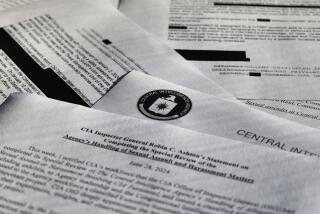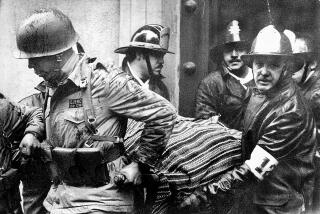Were CIA methods effective?
- Share via
WASHINGTON — The release of internal Bush administration interrogation memos this week answered long-standing questions about the CIA’s techniques for getting prisoners to talk, but left unsettled a debate in Washington over whether those methods worked.
The White House and the Senate Intelligence Committee are in the early stages of inquiries designed to address that issue, which nearly eight years after the Sept. 11 attacks remains one of the most divisive in the intelligence community.
In response to those efforts, the CIA has begun assembling thousands of classified cables that contain daily reports from the agency’s secret prisons, tracking the interrogation methods used on high-value detainees and how much information was obtained as a result.
The outcome of the studies could influence whether the U.S. government ever returns to interrogation tactics that were depicted as crucial to intelligence collection under President Bush but banned by President Obama during his first week in office.
In a measure of how highly charged the issue has become, critics of the decision to release the Justice Department memos said that doing so sabotaged the White House task force’s work almost before it had begun.
Former CIA Director Michael V. Hayden said that releasing the memos “moots the study that the president directed because it will take these techniques off the table because our enemy will know all our approaches.” Hayden and others also questioned the purpose of continuing to examine the effectiveness of the CIA program if there is no prospect that even the least severe of the methods could be restored.
--
Memo release
In a statement issued Thursday explaining his decision to release the memos, Obama suggested that the door was closed, saying his decision was driven in part by his desire “to ensure that the actions described within them never take place again.”
The White House and the Office of the Director of National Intelligence have declined to provide details on the work of the task force, which Obama established in January to examine the interrogation issue.
The task force was charged with evaluating CIA interrogation methods and making recommendations about whether the agency should be granted authority to use techniques that go beyond the boundaries of the U.S. Army Field Manual on Interrogation. A spokeswoman for the Director of National Intelligence declined to comment except to say the work of the task force would continue.
The task force is said to be looking into interrogation measures used by the FBI and the military as well as the CIA.
The Senate Intelligence Committee has launched a separate inquiry focused exclusively on assessing whether the methods used by the CIA in the aftermath of the Sept. 11 attacks worked.
A Senate Democratic aide involved in the matter said the release of the memos did not undercut its inquiry. Until now, the aide said, “the public record on what these techniques provided is exclusively what [former Vice President Dick] Cheney, Hayden and others have said.”
The aide also disputed suggestions that exposing the methods publicly would render them useless.
“There’s no secret about FBI and [military] interrogations, but they are still effective,” the aide said, speaking on condition of anonymity because he was not authorized to discuss the issue.
--
‘Black sites’
The memos released Thursday provide glimpses of the activities at the so-called black sites, secret U.S. prisons around the world. A 2002 document, for example, describes the rising frustration among CIA operatives with the level of cooperation they were getting from a suspected top Al Qaeda operative named Abu Zubaydah.
“The interrogation team is certain that he has additional information that he refuses to divulge,” including potential plots against the United States, a Justice Department official wrote.
Interrogators complained that Zubaydah, accused of being a key facilitator for the terrorist network, had become accustomed to the methods used against him, and they sought permission to move to “an increased pressure phase.”
Zubaydah eventually was subjected to a battery of interrogation methods, including sleep deprivation, being forced into a cramped box and the simulated drowning technique known as waterboarding.
The documents do not provide details on the results of the methods. Bush and U.S. intelligence officials have said that Zubaydah subsequently provided crucial intelligence that allowed the CIA to capture other Al Qaeda operatives -- including self-proclaimed Sept. 11 mastermind Khalid Shaikh Mohammed -- and disrupt a number of plots.
Current and former U.S. intelligence officials said the CIA’s cables on Zubaydah and other prisoners make a compelling case for restoring the agency’s ability to use certain coercive interrogation methods, even if the agency is permanently barred from the most severe techniques, such as waterboarding.
But critics have questioned the value of the intelligence provided by Zubaydah, as well as whether enhanced methods were necessary.
--
More to Read
Sign up for Essential California
The most important California stories and recommendations in your inbox every morning.
You may occasionally receive promotional content from the Los Angeles Times.










